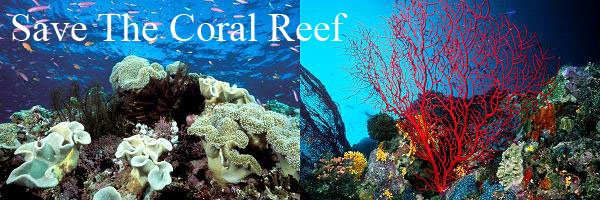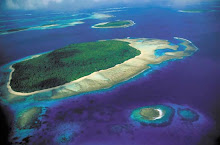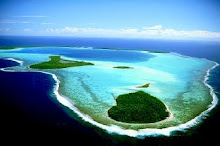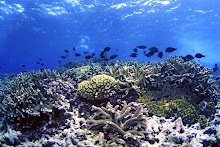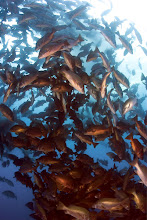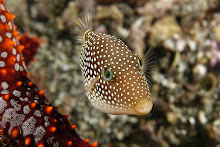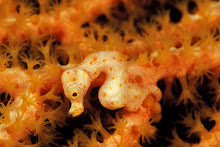What is a Coral Reef?
Coral Reef Formation
Marine Algae / Rock Crab on Pink Coralline Algae / Eelgrass
Types of Corals
Hard corals such as the brain corals, the star, elkhom corals and the pillar corals have rigid exoskeletons, or corallites, that protect their soft delicate bodies. Hard corals form the basis of coral reefs.
Staghorn Coral / Brain Coral / Star Coral
Types of Coral Reefs
- Fringing reefs are reefs that form along a coastline. They grow on the continental shelf in shallow water. Fringing reefs are commonly found in the South Pacific Hawaiian Islands, and parts of the Caribbean.
- Barrier reefs grow parallel to shorelines, but farther out, usually separated from the land by a deep lagoon. Barrier reefs form when land masses sink, and fringing reefs become separated from shorelines by wide channels. Land masses sink as a result of erosion and shifting crustal plates of the earth (Crustal plates lift or sink the seafloor and adjacent land masses). Barrier reefs are common in the Caribbean and Indo-Pacific. The Great Barrier Reef off northern Australian in the Indo-Pacific is the largest barrier reef in the world. This reef stretches more than 1,240 miles (2,000 km).
- Coral Atolls are rings of coral that grow on top of old, sunken volcanoes in the ocean. They begin as fringe reefs surrounding a volcanic island; then, as the volcano sinks, the reef continues to grow, and eventually only the reef remains. The reef becomes an atoll. Atolls are reefs that surround a central lagoon. The result is several low coral islands around a lagoon. Atolls commonly occur in the Indo-Pacific. The largest atoll, named Kwajalein, surrounds a lagoon over 60 miles (97 km) long.
Coral Reef Ecosystems

Clown Fish in their Sea Anemone
The coral provides shelter for many animals in this complex habitat, including sponges, nudibranchs, fish (like Blacktip Reef Sharks, groupers, clown fish, eels, parrotfish, snapper, and scorpion fish), jellyfish, anemones, sea stars (including the destructive Crown of Thorns), crustaceans (like crabs, shrimp, and lobsters), turtles, sea snakes, snails, and mollusks (like octopuses, nautilus, and clams). Birds also feast on coral reef animals.
Coral reef ecosystems are in a constant state of change. Corals grow and provide the framework for extension of the reef. Simultaneously, the reefs are being broken down by animals living in or feeding on the structure (sponges, bivalves, urchins, fish). If corals are damaged then the complex equilibrium of the reef will be permanently altered. The result would be loss of productivity and biodiversity, both of which would have a serious economic consequences.
Where are Coral Reefs?
Coral reefs develop in shallow, warm water, usually near land, and mostly in the tropics; coral prefer temperatures between 70 and 85 ° F (21 - 30 °C). T here are coral reefs off the eastern coast of Africa, off the southern coast of India, in the Red Sea, and off the coasts of northeast and northwest Australia and on to Polynesia. There are also coral reefs off the coast of Florida, USA, to the Caribbean, and down to Brazil.
The Great Barrier Reef (off the coast of NE Australia) is the largest coral reef in the world. It is over 1,257 miles (2000 km) long.
 Coral reefs only occupy less than one quarter of one percent of the earth's marine environment, but they are home to more than a quarter of all known fish species.
Coral reefs only occupy less than one quarter of one percent of the earth's marine environment, but they are home to more than a quarter of all known fish species.
Conditions for Coral Growth
Apart from temperature, corals also require clear waters. This is partly because they need sunlight to support the algae that live within their tissues. They are also very sensitive to particles of mud or sediment settling on them, which means that corals rarely grow close to rivers or other sources of sediment. In the sea, light is filtered out by depth, so reef-building corals can only grow in relatively shallow water. Even in the clearest oceans few reef-building corals grow below a depth of 80 to 100 m (260 to 328 ft).
Although corals need nutrients, they cannot thrive in areas where there are large amounts of nutrients. Typically, microscopic organisms in the plankton, or seaweeds (macroalgae), grow to excess in nutrient-rich water and smother the corals, blocking out the light.
Waves can often be seen crashing onto coral reefs. Being supported by limestone skeletons, corals can survive in very tough conditions. However, in the strongest storms many corals will be smashed to pieces. I n the short term this can be damaging, but many of the broken pieces will continue to grow. New corals will arrive from other areas, so the reef can recover, often within a few years.
Threats to Coral Reefs
Despite their considerable importance to humans, many coral reefs around the world are in decline. Some scientists estimate that 58 percent of the world’s coral reefs are at risk from human damage. The most threatened reefs are those of Southeast Asia, where some 82 percent of reefs are at risk. About 61 percent of the Caribbean reefs are also under considerable threat. In many cases these reefs are not simply threatened by one thing, but by a combination of natural and human-caused stresses.
- Natural Threats to Coral Reefs
Reefs have always been subject to natural threats. Storms and hurricanes regularly sweep across some tropical areas, bringing massive waves capable of smashing corals even at depths of 10 m (33 ft) or more. Heavy rainfall can also harm corals by bringing fresh water and sediments onto the reefs.
Certain creatures eat coral. This is usually a natural process on a coral reef, but one creature, the crown-of-thorns starfish, sometimes reaches plague proportions and can destroy all living coral on a reef in a few weeks. These plagues may be natural, and reefs can certainly recover. However, many scientists believe that overfishing of the natural predators of these starfish may be worsening the problem. S tarfish populations may also be growing because they benefit from increased fresh water and sediments.

Crown-of-Thorns Starfish (Acanthaster planci)
- Human Threats to Coral Reefs
The amount of sediments reaching the sea has increased rapidly over the past hundred years or more. This can be linked to the loss of forests and the development of new agricultural techniques that lay the land open to rain and erosion. The sediments are swept into the oceans through rivers and streams and, like the algae, can smother and kill the coral.
Fishing has been going on around coral reefs for thousands of years. Problems arise when too many people try to catch fish from the reefs, or when, often out of desperation, they turn to destructive measures to capture fish. The rapid growth of human populations, combined with the development of increasingly efficient fishing methods, means that reefs in many areas are overfished. The reefs have fewer and smaller fish than in the past, a disaster both for the reef ecosystem and for the fishers. In a few places, notably in Southeast Asia, some fishers use explosives to capture fish. These explosives kill all fish within a certain area, as well as destroying the corals nearby. It takes many years for these damaged areas to recover.
Even reefs remote from humans have been affected by fishing as certain target species, such as large fish, giant clams, and sharks, have become so valuable that fishing vessels are willing to travel considerable distances to capture the remaining individuals. Today it is rare to find a reef with its full complement of these magnificent creatures.
Coral Reef Movie: Republic of Palau
Palau is one of the seven underwater wonders of the world, with dugongs, saltwater crocodiles, 550 coral species, 300 species of sponges and 1,300 varieties of reef fish.
In 1998, Palau's corals were severely damaged by coral bleaching, whereby warmed ocean currents and too much sunlight penetrating the water turned corals white, brittle and lifeless. Nearly 99 percent of corals on some reefs died. Their subsequent recovery, however, and the study of those reefs that proved resilient to coral bleaching helped spark a new Conservancy-wide program.
In this video clip, learn more about Palau and what The Nature Conservancy is doing to protect one of the world's most diverse and fragile coral reefs.
Coral Reef Movie: Warm Climate and Acid Ocean Kills Coral Reefs
What you can do?
Our generation holds the future of coral reefs in its hands. If we fail to act now, coral reefs and the communities and cultures that depend on them may be lost forever. If you care about coral reefs and want to make a difference, there are lots of ways you can help.
- Be a Smart Consumer
Support the health of the oceans when you shop by understanding how your purchases can impact the environment.
- Live Sustainably
Conserving energy to reduce your carbon footprint is one way to fight the effects of global warning and lessen large-scale threats to reef ecosystems.
Take small but powerful and environmentally conscious steps like switching to compact fluorescent light bulbs, planting native trees, buying energy-efficient cars, and teleconferencing instead of flying.
Follow the 3 R's - reduce, reuse, recycle - to ameliorate the negative impacts of pollution and landfills on the health of our oceans.
- Educate Others
Whether you are a teacher, a student, or simply a concerned and responsible citizen, you have the ability to share your passion and knowledge with others. Because much of the visible damage to coral reef ecosystems happens deep in the ocean, many people don't realize that our reefs are in trouble, nor do they understand that this crisis will affect all of us, no matter where we live.
We need your help! Anything you can do to give, teach, or inspire on behalf of coral reefs is deeply appreciated, not only by CORAL, but also by the millions of creatures, human and otherwise, that depend on coral reefs. Thank you!
Easy Steps to Help Protect Coral Reefs
Do you want to make a difference every day? Want to learn about simple, effective actions you can take to help save coral reefs and the fish, animals, and plants that depend on them? You've come to the right place!
- Conserve water: The less water you use, the less runoff and wastewater will pollute our oceans.
- Help reduce pollution: Walk, bike or ride the bus. Fossil fuel emissions from cars and industry raise lead to ocean warming which causes mass-bleaching of corals and can lead to widespread destruction of reefs.
- Use only ecological or organic fertilizers: Although you may live thousands of miles from a coral reef ecosystem, these products flow into the water system, pollute the ocean, and can harm coral reefs and marine life.
- Dispose of your trash properly: Don't leave unwanted fishing lines or nets in the water or on the beach. Any kind of litter pollutes the water and can harm the reef and the fish.
- Support reef-friendly businesses: Ask the fishing, boating, hotel, aquarium, dive or snorkeling operators how they protect the reef. Be sure they care for the living reef ecosystem and ask if the organization responsible is part of a coral reef ecosystem management effort.
- Plant a tree: Trees reduce runoff into the oceans. You will also contribute to reversing the warming of our planet and the rising temperatures of our oceans.
- Practice safe and responsible diving and snorkeling: Do not touch the reef or anchor your boat on the reef. Contact with the coral will damage the delicate coral animals, and anchoring on the reef can kill it, so look for sandy bottom or use moorings if available.
- Volunteer for a coral reef cleanup: You don't live near a coral reef? Then do what many people do with their vacation: visit a coral reef. Spend an afternoon enjoying the beauty of one of the most diverse ecosystems on the Earth.
- Contact your government representatives: Demand they take action to protect coral reefs, stop sewage pollution of our oceans, expand marine protected areas and take steps to reverse global warming.
- Spread the word: Remember your own excitement at learning how important the planet's coral reefs are to us and the intricate global ecosystem. Share this excitement and encourage others to get involved.
Coral Reef Quiz - Test your Knowledge
Start testing your knowledge here!
Crossword Puzzle

Can you find the following words?
1) Coral Reefs
2) Bleaching
3) Home
5) Ecosystems
6) Anemone
7) Polyp
8) Hard Corals
9) Soft Corals
10) Mollusk
International Year of the Reef 2008

These are achieved by:
- Strengthening awareness about the ecological, economic, social and cultural value of coral reefs and associated ecosystems,
- Improving understanding of the critical threats to coral reefs and generate both practical and innovative solutions to reduce these threats,
